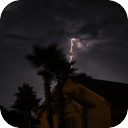(short preview of full seamless looping track)
Rolling Tropical Thunder
This product is not available in the selected currency.
In Stock
Backordered
Out of Stock
Description
The palm trees shake and bend out of respect to the crying of the mighty sky, opening its great mouth to speak its strange tongue and sing poetry to all creatures far and wide. You take this time to write your own poetry. Grabbing a pad and pen, you sit and watch the clouds light up and feel your ears vibrate, trying to capture every emotion that this great natural moment has to offer. The first few words are not a language you know, but your pen eventually finds a way to interpret every flash and bang above you. A tropical storm is an organized system of strong thunderstorms with a defined surface circulation and maximum sustained winds between 17 metres per second (33 kn) (39 miles per hour (63 km/h) and 32 metres per second (62 kn) (73 miles per hour (117 km/h)). At this point, the distinctive cyclonic shape starts to develop, although an eye is not usually present. Government weather services, other than the Philippines, first assign names to systems that reach this intensity. A tropical depression is an organized system of clouds and thunderstorms with a defined, closed surface circulation and maximum sustained winds of less than 17 metres per second (33 kn) or 38 miles per hour (61 km/h). It has no eye and does not typically have the organization or the spiral shape of more powerful storms. However, it is already a low-pressure system, hence the name "depression". Tropical cyclones are classified into three main groups, based on intensity: tropical depressions, tropical storms, and a third group of more intense storms, whose name depends on the region. For example, if a tropical storm in the Northwestern Pacific reaches hurricane-strength winds on the Beaufort scale, it is referred to as a typhoon; if a tropical storm passes the same benchmark in the Northeast Pacific Basin, or in the Atlantic, it is called a hurricane. Neither "hurricane" nor "typhoon" is used in either the Southern Hemisphere or the Indian Ocean. In these basins, storms of tropical nature are referred to simply as "cyclones".
Opps
Sorry, it looks like some products are not available in selected quantity.



